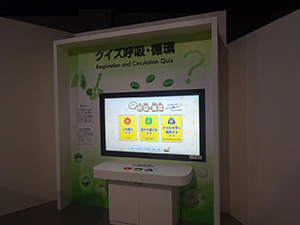Nagoya City Science Museum
TOP > Exhibition Guide > Keyword Search > Starting with "I" > immune_system > Respiration and Circulation Quiz
Respiration and Circulation Quiz



Purpose of Exhibition
When you answer the three-choice quiz on a topic of your choice, the monitor will display the right answer with a simple explanation. You can also read a detailed explanation. At the end, your results will be rated.
There are three topics. Have a go at slightly higher-level quizzes about blood and the respiratinon and circulation.
Additional Knowledge
[What Are Immunity and Vaccines?]
Immunity is a system that attacks anything different from the substances that exist in the body (“foreign substances”) to protect the body.
White blood cells memorize the shapes of foreign substances they have ever encountered. When white blood cells encounter foreign substances of these shapes again, they react more quickly and powerfully than the first time. This feature is utilized by vaccines (foreign substances whose toxicity is weakened or whose toxic actions are limited to certain ones). Vaccination introduces certain foreign substances into the body, and when the same types of foreign substances come, the body is able to control them quickly and powerfully to prevent disease.
However, if antigens change in shape to become different from those memorized, reaction to the changed antigens may weaker than expected. Vaccines cannot completely beat antigens that frequently change in shape (e.g., influenza viruses).
[Different Antibodies Are Produced against Different Foreign Substances]
B-lymphocytes are a type of white blood cell that produces Y-shaped antibodies that attack foreign substances. Antibodies are a type of protein called “immunoglobulin,” which is abbreviated as “Ig.”
Antibodies bind to foreign substances (called “antigens” in this context) to control their action and mark the antigens as targets of attack by other cells.
Antibodies look like the letter “Y,” and the tips of the two short arms come in many different shapes. So, your body can handle all types of antigens by producing antibodies that fit all the individual antigens.
Antibodies bind only to specific antigens, and this property is also applied to the measurement of minute amounts of substances.
[Susumu Tonegawa, Japan’s First Winner of the Nobel Prize in Physiology and Medicine]
Why can the body handle all types of antigens by producing antibodies that fit all the individual antigens? That is because antibody genes, which are “blueprints” of the antibodies, come in so many types. There are too many antibody genes to fit in B-lymphocyte cells, which are so small.
This mystery was unraveled by Dr. Susumu Tonegawa.
When the cells that are matured into B lymphocytes are still immature, they all have identical information, like a copy of a book, as the source of antibody genes. When the cells grow into mature B-lymphocytes, antibody genes are shorter, and the “blueprint data” differ between individual B-lymphocytes. No two blueprints are exactly alike. Why are there so many more types?
That is because only short fragments have been taken from multiple parts of the original gene and combined with each other.
This process can be compared to the reproduction of a thick book consisting of multiple chapters. Instead of copying all the pages of the book, only one page is picked from each chapter, and these pages are bound to make a thin book.
Depending on which pages are used from the individual chapters, there can be very many varieties of the thin book.
Dr. Tonegawa discovered that genes, which had been believed to remain unchanged from the original, are edited in terms of both length and content. For this achievement, he became the first Japanese to win the Nobel Prize in Physiology and Medicine (1987).
Article by Tomoko Horiuchi, curator
